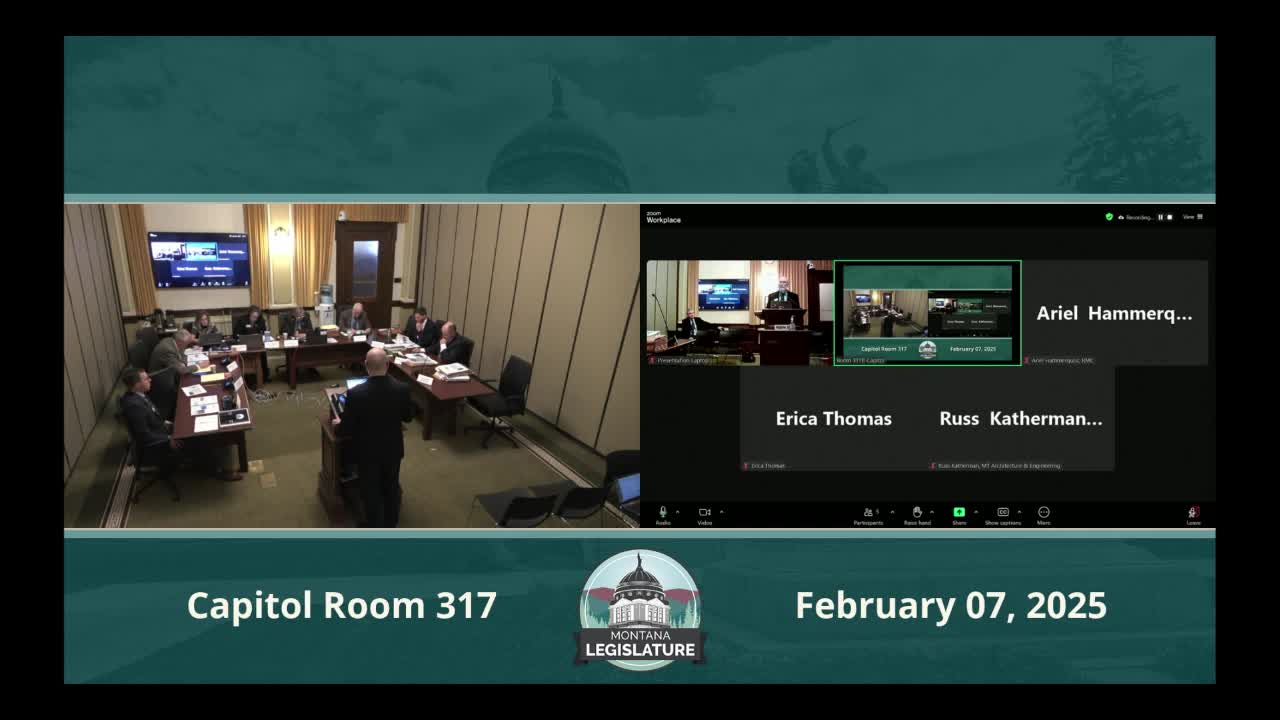Subcommittee reviews Guard aviation and facility projects, including phase‑2 work and Fort Harrison upgrades
February 07, 2025 | 2025 Legislature MT, Montana
This article was created by AI summarizing key points discussed. AI makes mistakes, so for full details and context, please refer to the video of the full meeting. Please report any errors so we can fix them. Report an error »

The subcommittee reviewed several Department of Military Affairs (DMA) capital requests, including phase‑2 components of the Army Aviation Support Facility in Billings, Fort Harrison vehicle maintenance and paint shop projects, and a larger vehicle maintenance shop and aircraft‑support work.
Why it matters: DMA witnesses and A&E staff told lawmakers that federal requirements, blast‑resistant standards and National Guard Bureau specifications drive design choices and increase costs. Several projects are constructed to federal standards so the National Guard Bureau can assume ongoing operation and maintenance when the work is complete.
Phase 2 at the Billings aviation facility would add fueling and storage, expand concrete apron area to protect aircraft from dust/grit, and supply other operational spaces. Witnesses said concrete aprons and federal operational standards are expensive but necessary for long‑term maintenance and for federal acceptance of the facility. Committee members asked whether asphalt could be used in some apron areas; witnesses said National Guard Bureau requirements can limit alternative materials if the federal government will pick up operations and maintenance.
At Fort Harrison, the subcommittee examined a proposed new barracks, a vehicle paint shop and other maintenance buildings. Witnesses provided recent comparable Montana construction costs but acknowledged nationwide federal standards and specialized equipment (ventilation and exhaust systems for paint shops, hardened construction) increase budgets for Guard facilities relative to typical commercial projects.
Senators and representatives requested cost comparisons to recent Montana projects and asked DMA and A&E to provide contractor lists and local bid history. DMA and A&E said they would supply detailed comparisons, confirm whether Montana contractors bid similar projects, and refine numbers for the committee.
What’s next: DMA and A&E agreed to provide comparable Montana project data, local contractor participation information, and any federal guidance documents that materially affect scope and cost.
Why it matters: DMA witnesses and A&E staff told lawmakers that federal requirements, blast‑resistant standards and National Guard Bureau specifications drive design choices and increase costs. Several projects are constructed to federal standards so the National Guard Bureau can assume ongoing operation and maintenance when the work is complete.
Phase 2 at the Billings aviation facility would add fueling and storage, expand concrete apron area to protect aircraft from dust/grit, and supply other operational spaces. Witnesses said concrete aprons and federal operational standards are expensive but necessary for long‑term maintenance and for federal acceptance of the facility. Committee members asked whether asphalt could be used in some apron areas; witnesses said National Guard Bureau requirements can limit alternative materials if the federal government will pick up operations and maintenance.
At Fort Harrison, the subcommittee examined a proposed new barracks, a vehicle paint shop and other maintenance buildings. Witnesses provided recent comparable Montana construction costs but acknowledged nationwide federal standards and specialized equipment (ventilation and exhaust systems for paint shops, hardened construction) increase budgets for Guard facilities relative to typical commercial projects.
Senators and representatives requested cost comparisons to recent Montana projects and asked DMA and A&E to provide contractor lists and local bid history. DMA and A&E said they would supply detailed comparisons, confirm whether Montana contractors bid similar projects, and refine numbers for the committee.
What’s next: DMA and A&E agreed to provide comparable Montana project data, local contractor participation information, and any federal guidance documents that materially affect scope and cost.
View full meeting
This article is based on a recent meeting—watch the full video and explore the complete transcript for deeper insights into the discussion.
View full meeting
